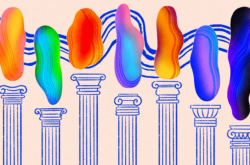Illustration: Nhung Lê
The Ionian mode is one of the seven common diatonic modes.
Sharing all of the same pitches with the major scale, the Ionian mode can be used in an incredibly wide range of musical contexts. In this article, let’s discuss what exactly the Ionian mode is, how it differs from major, some popular tracks that make use of it, and how to apply it to your own music.
Feel free to use the table of contents below to quickly navigate to a specific section.
What you’ll learn:
- What is the Ionian mode?
- The Ionian scale formula
- The Ioanian scale in all “keys”
- Songs that use the Ionian mode
- When to use the Ionian mode in your music
Let’s get started!
What is the Ionian mode?
As mentioned above, the Ionian mode is a mode that shares all of the same pitches as the major scale. If we started on C, then its ascending scale would consist of C, D, E, F, G, A, B, and C.

The C Ionian scale
The history of the Ionian mode
The Ionian mode was first formally named by Swiss music theorist Heinrich Glarean in the 16th century in his influential text Dodecachordon. The name is a reference to the ancient Greek region of Ionia, an area that corresponds to the western coast of present-day Turkey.
Across the medieval, Renaissance, and Baroque periods, the Ionian mode evolved to contain the pitches that we now know as the major scale and played a key role in the development of polyphonic music. Today, it’s used as the backbone of various genres including pop, jazz, rock, and more, often to evoke various shades of feelings such as happiness, optimism, and brightness.
The Ionian scale formula
As you can decipher from the previous example, the Ionian scale consists of the following intervals:
- Root
- Major second
- Major third
- Perfect fourth
- Perfect fifth
- Major sixth
- Major seventh
If you were to sequence an ascending scale, the intervals could be expressed in shorthand as WWHWWWH (‘whole whole half, whole whole whole half’).
Once you familiarize yourself with this pattern, you can apply it to build an Ionian scale off of any other root note. For example, here are the notes for a G Ionian scale using this formula:
- G
- A
- B
- C
- D
- E
- F♯
- G
Transposing the root to A, here are the notes for an A Ionian scale:
- A
- B
- C♯
- D
- E
- F♯
- G♯
- A
If you’re a guitarist, you can refer to the following tablature for a transposable scale:

What’s the difference between the Ionian mode and major?
With 100% of the notes shared in common, you might be wondering what the difference is between the Ionian mode and major. Similar to how we think about the distinction between the Aeolian mode and natural minor, the truth is, colloquially they’re often used interchangeably—many will refer to a piece that relies on major as Ionian, and vice versa.
However, if we want to be precise, the primary distinction is whether functional harmony—and dominance in particular—is emphasized by the music. A song that’s major revolves around the tonic / dominance relationship, and will feature cadences like V – I, ii – V – I, and IV – V – I. Meanwhile, with Ionian, there’s less emphasis on the tension and resolution achieved by such cadences—while the root is still the ‘home base,’ it’s generally a more seamless exploration of all of the pitches in the mode.
The Ionian mode in all “keys”
While familiarizing yourself with the sequence of intervals is far more valuable (and easier) than memorizing each and every scale one-by-one, here’s a table that outlines the Ionian scale associated with every root note for easy reference:
| Root | Notes in the Ionian scale |
| C | C – D – E – F – G – A – B – C |
| C♯ | C♯ – D♯ – E♯ – F♯ – G♯ – A♯ – B♯ – C♯ |
| D♭ | D♭ – E♭ – F – G♭ – A♭ – B♭ – C – D♭ |
| D | D – E – F♯ – G – A – B – C♯ – D |
| D♯ | D♯ – E♯ – F♯♯ – G♯ – A♯ – B♯ – C♯♯ – D♯ |
| E♭ | E♭ – F – G – A♭ – B♭ – C – D – E♭ |
| E | E – F♯ – G♯ – A – B – C♯ – D♯ – E |
| F | F – G – A – B♭ – C – D – E – F |
| F♯ | F♯ – G♯ – A♯ – B – C♯ – D♯ – E♯ – F♯ |
| G♭ | G♭ – A♭ – B♭ – C♭ – D♭ – E♭ – F – G♭ |
| G | G – A – B – C – D – E – F♯ – G |
| G♯ | G♯ – A♯ – B♯ – C♯ – D♯ – E♯ – F♯♯ – G♯ |
| A♭ | A♭ – B♭ – C – D♭ – E♭ – F – G – A♭ |
| A | A – B – C♯ – D – E – F♯ – G♯ – A |
| A♯ | A♯ – B♯ – C♯♯ – D♯ – E♯ – F♯♯ – G♯♯ – A♯ |
| B♭ | B♭ – C – D – E♭ – F – G – A – B♭ |
| B | B – C♯ – D♯ – E – F♯ – G♯ – A♯ – B |
We use the term “key” loosely to refer to these, because again, modes don’t follow the same functional behaviors of traditional major keys, which are a requisite of the term in its strictest definition. Also note that many of these are enharmonically equivalent—for example, the modes built off of A♯ and B♭ share all of the same pitches, but are simply expressed differently in writing.
Songs that use the Ionian mode
While scales are a necessary starting point, they don’t paint a vivid picture of the Ionian mode’s sound by themselves. Let’s begin to familiarize ourselves with the mode by listening to a few pieces of music from varying genres and contexts that feature its sound, and explore what makes them feel distinctly Ionian as opposed to major.
1. “Never Meant” by American Football (1999)
Perhaps somewhat ironically, emo music is full of effective uses of the Ionian mode. Take a listen to the iconic guitar arrangement in American Football’s “Never Meant,” for example, which takes advantage of the lack of cadences in the Ionian mode to create a gentle, flowing texture. The brighter sound of the mode also pairs beautifully with the ostensibly sad lyrics to achieve a complex, bittersweet feel.
2. “Undertale” by Toby Fox (from UNDERTALE) (2015)
Toby Fox’s main theme from the beloved UNDERTALE soundtrack makes use of the Ionian mode to convey an understated but swelling feeling of optimism. It starts with a melodic idea that features the tug from the leading tone up to the tonic, which does evoke a major sound—but the root serving as a continuous pedal against it maintains an overall Ionian feel. As more melodies and countermelodies are layered over it as the piece progresses, we get a soupy arrangement that feels distinctly Ionian.
3. “Something Comforting” by Porter Robinson (2021)
Last but not least, we have a modern electro-pop example in Porter Robinson’s “Something Comforting.” In a similar vein to “Never Meant,” Porter Robinson pairs the mode with tugging lyrics and emotive piano and synth arrangements to create a nostalgic, introspective sound.
Using the Ionian mode in your songs
Arguably the most popular mode alongside Aeolian, the Ionian mode is highly versatile and widely applied. Because of this, it’s simply impossible to capture all of its use cases, but below are a few common themes if you’re wondering when and how you should use the mode in your music.
1. Introduce an element of optimism
The Ionian mode is most commonly associated with a ‘happy’ sound, and there are countless examples of it being used in unapologetically bright and cheerful music. However, the above songs also demonstrate that the Ionian mode can be combined with contrasting elements—whether it’s lyrics, arrangements, or timbres—to also capture more nuanced emotions like nostalgia, comfort, and even melancholy.
2. Complement lyrical themes
In a similar vein, if your song’s lyrics center around themes like celebration, love, freedom, or hope, the Ionian mode can provide a harmonic backdrop that creates cohesion between the music and the lyrics, elevating what your words are trying to convey. That said, you can also creatively pair it with sad or introspective lyrics to create emotional subtleties or imply irony.
3. Bring out the characteristics of other modes
Due to its prevalent nature, the Ionian mode might not be as immediately ear-catching as the other diatonic modes. If you’re employing modal mixture or modal interplay in your music, you can use its ‘vanilla’ sound to your advantage, juxtaposing the Ionian mode against the other modes to further emphasize their defining pitches.
Conclusion
While there’s far from just one way to use it, the Ionian mode provides an iconic color that’s essential to any musician’s toolkit. Hopefully this guide gave you a foundation for how it’s structured, and provided you with some initial ideas for using it that you can apply to create your own unique musical settings.
Do you have any questions around using modes in your music? What other topics in music theory would you like to see us cover next? Start a conversation with us and other music creators via the Splice Discord.
Continue your exploration of modes in music:
July 14, 2023



